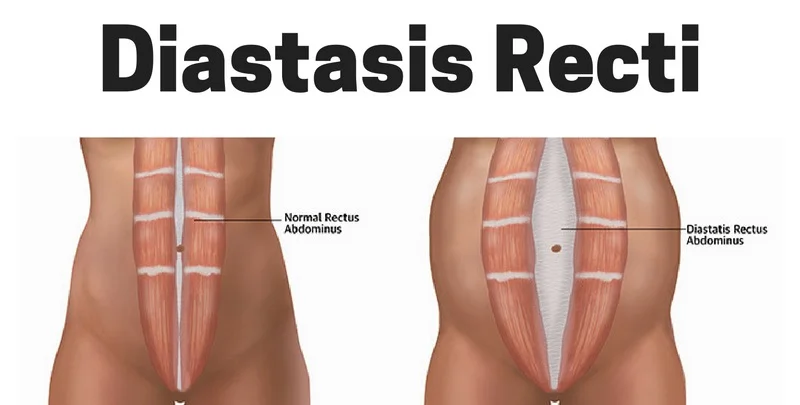What is Diastasis Recti and How Do You Treat It?
Diastasis Recti: Post-partum Abdominal Separation
Many women aren't very well educated about diastasis recti before or after giving birth, even though almost 70% of women end up with some form of diastasis recti. Postpartum fitness isn't something all doctors necessarily explain to their patients.
They’re understandably concerned about other things, like proper internal healing and the overall health of the mother and child, but diastasis recti is an important topic to discuss with new moms, as is how to treat it.
Diastasis Recti: The image on the left is someone with a normal rectus abdominus, while the image on the left is someone who has diastasis recti, with their “six pack” muscle split and separated.
What is Diastasis Recti? The “Split Six Pack”
Diastasis recti is a common condition after pregnancy, where the Rectus Abdominus muscle (the one you can see when someone has a "six pack") splits down the middle and no longer stays together. This can cause issues for support of the internal organs, and make it very difficult to regain muscle strength without specific exercise protocols targeting the right muscles.
Diastasis recti is sometimes referred to as a “split six pack” because it looks like the six pack is split in the center.
Diastasis Recti Pregnancy Facts:
Pregnancy puts so much internal pressure on the belly that sometimes the muscles in front can’t keep their shape, which are already stretched from the expanding uterus and pregnancy hormones.. "Diastasis" means separation. "Recti" refers to your ab muscles called the "rectus abdominis."
It's very common among pregnant women: more than two-thirds of pregnant women have it.
The muscle opening in the diastasis rectum often shrinks after giving birth, but in some studies of women with diastasis recti, the muscle wasn't back to normal even one year later.
When the connective tissue has healed, some Pilates or other exercises may help you strengthen and rely more on your transverse (deep core) belly muscles instead of the outer ones.
There is still a lot to study and learn about diastasis recti.
Some Diastasis Recti Symptoms:
Bulge in stomach when you contract your abdominal muscles
Poor posture
Lower back pain
Bloating
Health Line has a good way to self-check for diastasis recti.
Why It’s Important to Educate Women on Diastasi Recti
Unfortunately, I’ve worked with many mothers over the years and many of them weren't even aware that they had Diastasis Recti, years after their pregnancy.
We had to work together to figure out what exercises they are capable of performing, and what exacerbates the damage to the superficial muscle.
Many of the traditional abdominal strengthening exercises are targeted towards the Rectus Abdominis, but those will only make the “split six pack” worse. If you work the Transverse Abdominis instead (which is what we focus on during Pilates workouts I do with my clients) you will pull your abs together, and down toward your spine, which alleviates the strain on the Rectus Abdominis.
It’s important to know if you have diastasis recti, so you can choose the right fitness plan and workout moves to keep you as healthy as possible while getting you to your pre-pregnancy shape!
And it’s also important to know about diastasis recti before you get pregnant, so you can strengthen your pelvic muscle floor and abdominal muscles before pre-pregnancy or during pregnancy.
How Do You Treat Diastasis Recti?
There a specific exercises to avoid, and exercises to try, when trying to treat diastasis recti, either directly postpartum, or years later. So, make sure you ask your doctor, or trainer if you’re working with them, to make sure you’re doing the right exercises for your body.
Exercises that can make Diastasis Recti worse:
Planks (the classic plank)
Sit Ups
Crunches
Toes to Bar
Other movements that require flexion of the torso
Exercises that can help treat Diastasis Recti:
Exercises targeting the pelvic floor muscles
Stabilization exercises for the pelvis and low back, such as the Pilates "series of 5" (without lifting the head and chest)
Upright body weight movements, such as squats
Side planks (when performed correctly)
Deep breathing exercises
Diastasis recti can be tricky to treat, so if you have any questions on where to get started, make sure to email me or DM me on Instagram.. If you don’t have diastasis recti, but are worried about prevention, please reach out as well.

